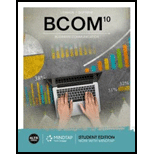
Concept explainers
1.
To determine:
The correct verb from the bracket for the given statement.
Introduction:
Verb is one of the parts of speech in English grammar. A verb in simple language means action. The verb always represents an action or a state of being. It constructs a major portion of the predicate in a sentence.
A basic necessity in a sentence is the subject-verb agreement. This simply means that one cannot say ‘I are/is’, but say ‘I am’. A singular subject in a sentence must be accompanied with a singular verb and plural subjects are to be accompanied by plural verb.
2.
To determine:
The correct verb from the bracket for the given statement.
Introduction:
Verb is one of the parts of speech in English grammar. A verb in simple language means action. The verb always represents an action or a state of being. It constructs a major portion of the predicate in a sentence.
A basic necessity in a sentence is the subject-verb agreement. This simply means that one cannot say ‘I are/is’, but say ‘I am’. A singular subject in a sentence must be accompanied with a singular verb and plural subjects are to be accompanied by plural verb.
3.
To determine:
The correct verb from the bracket for the given statement.
Introduction:
Verb is one of the parts of speech in English grammar. A verb in simple language means action. The verb always represents an action or a state of being. It constructs a major portion of the predicate in a sentence.
A basic necessity in a sentence is the subject-verb agreement. This simply means that one cannot say ‘I are/is’, but say ‘I am’. A singular subject in a sentence must be accompanied with a singular verb and plural subjects are to be accompanied by plural verb.
4.
To determine:
The correct verb from the bracket for the given statement.
Introduction:
Verb is one of the parts of speech in English grammar. A verb in simple language means action. The verb always represents an action or a state of being. It constructs a major portion of the predicate in a sentence.
A basic necessity in a sentence is the subject-verb agreement. This simply means that one cannot say ‘I are/is’, but say ‘I am’. A singular subject in a sentence must be accompanied with a singular verb and plural subjects are to be accompanied by plural verb.
5.
To determine:
The correct verb from the bracket for the given statement.
Introduction:
Verb is one of the parts of speech in English grammar. A verb in simple language means action. The verb always represents an action or a state of being. It constructs a major portion of the predicate in a sentence.
A basic necessity in a sentence is the subject-verb agreement. This simply means that one cannot say ‘I are/is’, but say ‘I am’. A singular subject in a sentence must be accompanied with a singular verb and plural subjects are to be accompanied by plural verb.
6.
To determine:
The correct verb from the bracket for the given statement.
Introduction:
Verb is one of the parts of speech in English grammar. A verb in simple language means action. The verb always represents an action or a state of being. It constructs a major portion of the predicate in a sentence.
A basic necessity in a sentence is the subject-verb agreement. This simply means that one cannot say ‘I are/is’, but say ‘I am’. A singular subject in a sentence must be accompanied with a singular verb and plural subjects are to be accompanied by plural verb.
6.
To determine:
The correct verb from the bracket for the given statement.
Introduction:
A determiner is a grammatical modifier that is used in order to make tge noun more specific in nature. The determiner thus then shows that it has a connection with the mentioned noun.
Trending nowThis is a popular solution!

- Can you help me solve this general accounting question using the correct accounting procedures?arrow_forwardno ai Please don't answer i posted blurred image mistakely. please comment below i will write values. if you answer with incorrect values i will give unhelpful confirm.arrow_forwardYou will be conducting a strategic analysis of the country and product you selected in module one. You will explore the optimal way for an AI-powered smart standing desk into the foreign country of Vietnam and develop a marketing plan to support its entry into this new market. Executive Summary The Executive Summary, which is always written last, is a high-level overview and provides major highlights of your project, you will add this to your submission in module 7 and it will appear first in your paper after your cover page. This week's submission should include the following: Company and Product Description Provide a detailed description of the company Provide a detailed description of the product Outline and explain the advantages of your product Describe a list of product benefits and features Discuss any additional product line opportunities you may consider for your target market Objectives and goals Identify the aims and goals of your plan in this section of the…arrow_forward
 Management, Loose-Leaf VersionManagementISBN:9781305969308Author:Richard L. DaftPublisher:South-Western College Pub
Management, Loose-Leaf VersionManagementISBN:9781305969308Author:Richard L. DaftPublisher:South-Western College Pub Understanding Management (MindTap Course List)ManagementISBN:9781305502215Author:Richard L. Daft, Dorothy MarcicPublisher:Cengage Learning
Understanding Management (MindTap Course List)ManagementISBN:9781305502215Author:Richard L. Daft, Dorothy MarcicPublisher:Cengage Learning


